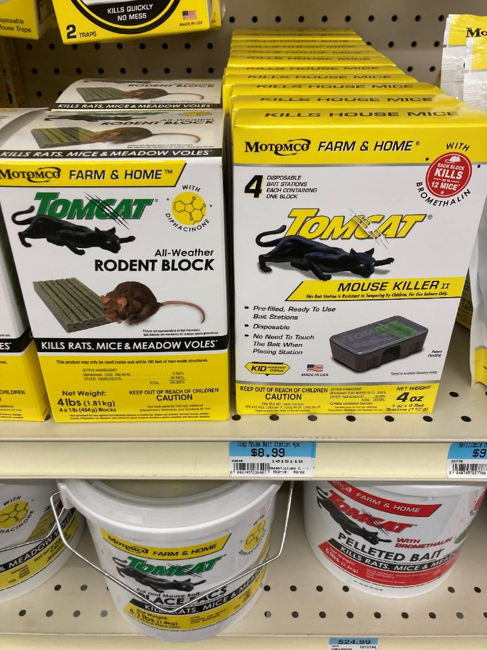
September 2022
Rodenticide Poisoning
By Scott Fritz, DVM, DABVT
Fall is quickly approaching and while we look forward to cooler temps, football, and family time, we need to keep in mind some seasonal activities may be risky for companion animals. Winterizing our campers and houses often means deploying some sort of rodenticide. This article is a review of the common rodenticides available for over-the-counter (OTC) purchase at retailers everywhere. There are four main groups of rodenticides, each with its own mechanism of action and clinical presentation in non-target species.
Anticoagulant rodenticides are probably the most well-known group of rodenticides and are still readily available today. From a pet owner standpoint, this is the safest group of rodenticides for our pets to accidentally consume. Dogs are more sensitive to these compounds than cats. These compounds interrupt the activation of vitamin K which is necessary for the body to manufacture clotting factors. The vitamin K dependent clotting factors (II, VII, IX, and X) have different half-lives, but clinical signs are typically delayed 3-5 days after an animal consumes a large enough dose. Clinical signs are the result of hemorrhage, but can be quite variable depending upon the site of hemorrhage. A large percentage of animals will hemorrhage into the lungs, thus, epistaxis and hemoptysis are common with concurrent lethargy, exercise intolerance, dyspnea, and pale mucous membranes. Animals can bleed from virtually any site so clinical signs may include melena, hematuria, lameness, paralysis, abdominal distension, or bruising of the skin. Confirmatory testing is available at KSVDL (TOX-1016 Anticoagulant panel), appropriate samples include serum, plasma, liver or bait material. Identifying the compound can influence the duration of therapy. Vitamin K1 is antidotal but coagulation may be delayed for up to 12 hours, blood transfusions may be necessary in extreme cases.
Bromethalin is another common compound found in OTC rodenticides, unlike the anticoagulants, cats are more sensitive to bromethalin than dogs. Bromethalin uncouples oxidative phosphorylation in mitochondria, especially in the brain. Oxidative phosphorylation is necessary for energy production in the form of ATP. ATP is necessary for the function of ATP-dependent sodium and potassium ion pumps. Impaired ion pump function leads to electrolyte imbalances in the brain and fluid moves into myelinated regions resulting in the cerebral edema responsible for the clinical signs described in case of bromethalin toxicosis. Bromethlin can cause different clinical signs depending on the magnitude of the dose consumed. Large doses are typically uncommon and clinical signs occur within 2-24 hours, these signs include severe tremors, hyperexcitability and seizures. Lower dose exposures are more common clinically and result in a delayed onset of milder clinical signs. Signs may be delayed for several days and include hind-limb ataxia and paresis (similar to tick paralysis or botulism) which can progress to seizures if untreated. Confirmatory post-mortem testing is difficult and typically involves identifying the toxic metabolite desmethylbromethalin in brain or fat. There is no antidote for bromethalin toxicosis.
Cholecalciferol rodenticides are also available, and the clinical presentation is identical to vitamin D toxicosis from ingestion of vitamin D supplements. Clinical signs are relatively nonspecific and are typically delayed 36-48 hours post-exposure. Anorexia, weakness and depression may be identified early in the progression of signs followed by vomiting, polyuria/polydipsia and dehydration as renal function deteriorates. Acute renal failure develops within 2-3 days of exposure. Hypercalcemia and hyperphosphatemia are readily identified and are commonly elevated enough to result in soft-tissue mineralization. Treatment of clinical cases is expensive and drawn-out. Various combinations of calcitonin, bisphosphonates, corticosteroids and loop diuretics have been used historically. Prognosis is typically guarded to poor in cases with hypercalcemia, hyperphosphatemia and soft tissue mineralization.
The last group of insecticides are the phosphides. Zinc and aluminum phosphide are available for purchase, zinc phosphide is the most common. Zinc phosphide is typically used underground to target moles and gophers. The zinc portion is a strong emetic which can be protective in non-target species. In an acidic environment like the stomach, the zinc portion is cleaved and results in the production of phosphine gas which is a dangerous systemic poison. Clinical signs occur rapidly, often within an hour of exposure. Clinical signs include severe gastrointestinal signs and hemorrhage, with rapid progression to systemic signs including cellular hypoxia, shock, convulsions, and death. Phosphine gas is a hazard for veterinary staff, and affected animals should be handled in a well-ventilated space or outdoors. Phosphine gas has a fishy or garlic smell that is detectable by humans around 2ppm, this is double the EPA limit of 1 ppm for brief exposures. Therapy is typically supportive in nature and the common moniker “Treat the Patient not the Poison” is applicable. Despite the severity of clinical signs many dogs can make a full recovery, especially those that survive the first 24 hours. There is no antidote for the phosphides, antacid therapy and decontamination can be effective, but care should be taken to protect veterinary staff.
 |
| Photo 1: Both Tomcat products, both treated blocks, one an anticoagulant, the other bromethalin. |
It is important for a clinician to remember that there are many different types of rodenticides available for OTC purchase. Histories of “rat poison” ingestion need more investigation to determine expected clinical signs, therapeutic intervention, and prognosis. Many brands have both anticoagulant and bromethlin baits under the same name (Photo 1). Manufacturers add dies to many baits making post-mortem examination of stomach contents worthwhile, the color does not have any bearing on the compound present. Ideally, the package label can be referenced to identify the compound in question.
Dr. Fritz is a board-certified toxicologist and PhD student in the KSVDL Toxicology section.